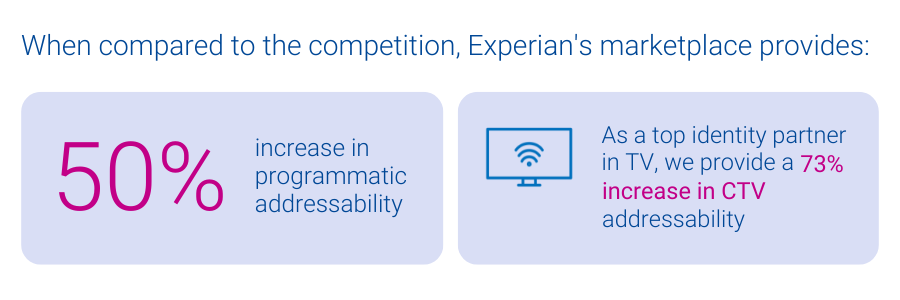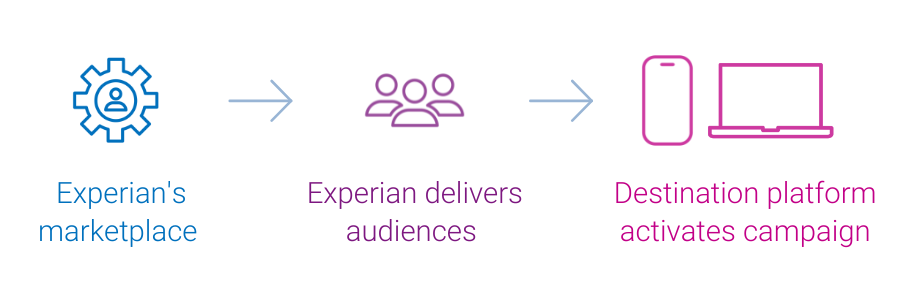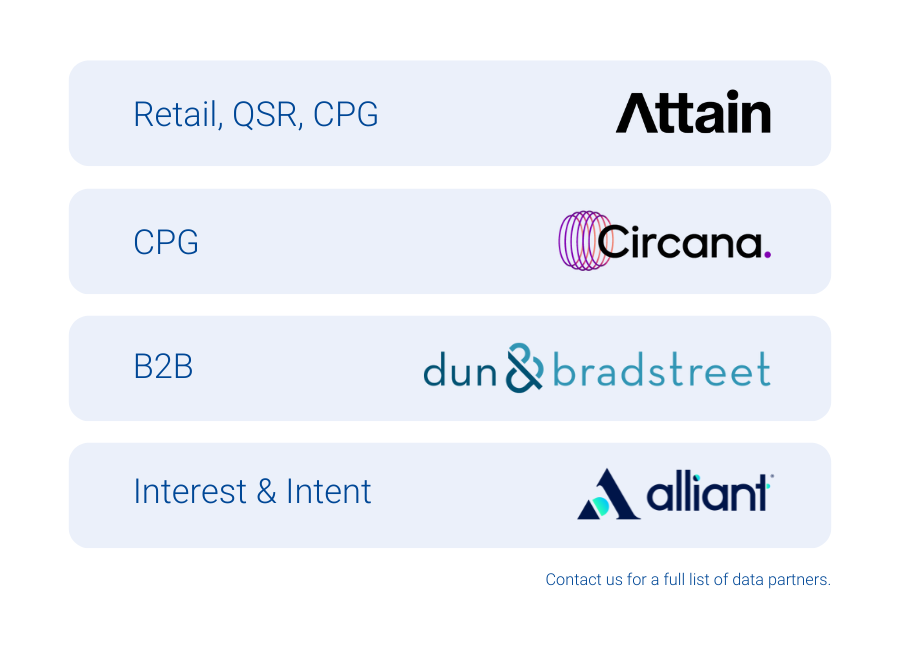
In a perfect world, we’d all have a single, go-to grocery store that carried everything on our shopping list – fresh produce, gourmet coffee beans, rare spices, and maybe even that special-grade olive oil, right alongside our wholesale bulk purchases at unbeatable prices. It would be convenient and efficient, and it’d save a lot of driving around town.
The changing data marketplace: From one-stop shop to specialized selection
For a long time, data buyers enjoyed something similar in their world: a small set of large-scale data marketplaces that offered a wide array of audiences, making it easy to load up on whatever you needed in one place. Not only are there fewer places to pick everything up, but new factors like privacy and signal deprecation are placing a spotlight on quality and addressability.
Just as our dinner plans are growing more ambitious insofar as we want health, flavor, value, and convenience all in one place – so are our data strategies. Instead of a single steak-and-potatoes meal, today’s data marketplace operators might be cooking up a complex menu of campaigns.
“Experian has been a longstanding partner of DISH Media, and we’re excited to be an early adopter of their marketplace which leverages the foundation of their identity solutions to ensure maximum cross-channel reach as we look to expand the breadth and depth of data we use for addressable TV.”
Kemal Bokhari, Head of Data, Measurement & Analytics, DISH Media
As a result, data buyers are beginning to shop around. Some still rely on large-scale marketplaces for familiar staples, but now they have reasons to explore other options. Some are turning to providers known for offering top-tier, transparently sourced segments. Others are focusing on specialty providers that excel in one area.
A more selective approach to data buying
In this environment, choosing where to “shop” for data is becoming more deliberate and selective. Data buyers aren’t just thinking about broad scale; they’re looking to prioritize quality, durability, data privacy, and differentiation. They need to place higher value on data marketplaces that can maintain audience addressability over time, despite signal loss. Sometimes, that means accepting a smaller assortment in exchange for tighter vetting and more reliable targeting. Other times it means mixing and matching – stopping by one marketplace for premium segments and another for cost-friendly, wide-reaching data sets. Either way, they can benefit from having more choices.
“Experian has been a longstanding partner of DISH Media, and we’re excited to be an early adopter of their marketplace which leverages the foundation of their identity solutions to ensure maximum cross-channel reach as we look to expand the breadth and depth of data we use for addressable TV.”
Kemal Bokhari, Head of Data, Measurement & Analytics, DISH Media
Experian’s marketplace: A trusted source for high-quality data
Experian’s vetted and curated blend of data partners and vertically-aligned audiences offers a trusted specialty store for data buyers. Experian’s marketplace, powered by identity graphs that include 126 million households, 250 million individuals, and 4 billion active digital IDs, enables partner audiences to be easily activated and maintain high addressability across display, mobile, and connected TV (CTV) channels. In particular, Experian’s marketplace provides:


The future of data marketplaces: Precision and flexibility matter
The evolution of data marketplaces reflects the industry’s shifting priorities. Data buyers seek specificity, reliability, and adaptability to align with their diverse campaign needs. The best data strategy, much like the best grocery run, isn’t about grabbing everything in one place – it’s about carefully selecting the right ingredients to create the perfect recipe for success. This shift underscores the importance of flexibility and precision as data buyers navigate a landscape shaped by privacy regulations, signal loss, and evolving consumer expectations.

As data marketplaces adapt to meet these demands, they are redefining what it means to deliver value. Experian’s marketplace enables buyers to strike the perfect balance between reach and quality by offering enhanced match rates, precise audience planning, and seamless distribution. In this new era, data buyers have the tools and options to craft campaigns that are impactful and aligned with the increasingly selective and privacy-conscious digital landscape. The key is recognizing that today’s data strategy is about utilizing the strengths of many to create a cohesive and effective whole.
If you’re interested in learning more about Experian’s marketplace or becoming an active buyer or seller in our marketplace, please contact us.
Latest posts

As part of our ongoing series which focuses on consumer and marketing trends around major holidays throughout the year, we’ve just released the Father’s Day Hot Sheet. Father’s Day gift-related searches Now that Mother’s Day has come and gone, consumers will be shifting their focus to dad. According to Experian Marketing Services’ Hitwise® online intelligence tool, searches for “Father’s Day” typically start to pop up on Mother’s Day. And searches for “Father’s Day gifts” tend to focus on affordable gift ideas that are personalized, unique and often handmade. In fact, two of the top variations of Father’s Day gift-related searches from 2014 were for “DIY” and “homemade” gifts. While many shoppers wanted the “best” gift for dad, others simply wanted something “cheap” or “last minute.” Finding a gift that dad will appreciate means looking for something that is personalized to him. As such, searches for Father’s Day gifts often contain additional information about the dad or, in many cases, grandpa. Examples commonly used in 2014 were “Christian dad,” “new dads,” “outdoorsy dads” as well dads who are wine or BBQ lovers. While many gift searches include information about the intended recipient, others mention details about the gift-giver or their relationship to the father. Among last year’s variations that included such details, nearly a third focused on gifts that were intended to be given by a “daughter.” Genderless references, such as “kids” or “children” were almost as common. Interestingly, fewer than ten percent were for gifts to be given by a “son.” About a fifth of searches included details about the age of the gift-giver (e.g.: “baby,” “toddler” or “first grader”), while others specified that the gift was to be given by the dad’s wife or girlfriend. Go, go, gadget dad! Gadgets and gizmos are always popular gifts for the techie dad. In fact, during the week immediately preceding Father’s Day last year, visits to Electronics and Appliance websites were up a relative eight percent from two weeks prior. Visits subsequently tapered off the following week. An analysis of search terms driving traffic to the Hitwise Electronics and Appliance industry the week ending June 14 versus May 13, 2014 also sheds some light on the specific items that Father’s Day gift-givers were likely to have been seeking out. Two GPS systems (“Magellan GPS” and “Tom Tom”) were among the top terms that grew search share in the weeks leading into Father’s Day last year. Likewise, “GoPro” appeared in two separate fast growing search terms. Gadgets like these and others listed in the adjacent table may be big gifts for the gadget-loving dad again this year. Gone fishin’ Fishing is a timeless family pastime enjoyed by millions of Americans. According to Experian Marketing Services’ Simmons® National Consumer Study, 28 percent of dads and 26 percent of kids ages six to 17 went fishing last year. As such, it’s no surprise that online searches related to fishing spike over Father’s Day weekend. On the Saturday before Father’s Day in 2014, searches including “fishing” were a relative 28 percent higher than they were the Saturday prior and 64 percent higher than they were the following Saturday. To better understand what kids and dads were seeking out for their fishing plans, Experian Marketing Services conducted an analysis comparing variations of “fishing” searches immediately before Father’s Day last year to those performed two weeks prior. It turns out the word “techniques” was almost 8.6 times more likely to appear in fishing-related searches just before Father’s Day than it was two weeks earlier and “tips” was four times more likely to be used. Likewise, “licenses” was used 2.3 times more frequently, which along with the higher use of “techniques” and “tips” is evidence that many would-be fishermen and women are occasional participants at best. The fact that “charter” and “cabins” were used at higher rates however suggests that other children and/or dads had something in mind beyond a lazy (and likely more affordable) afternoon at the local fishing hole. Gift items, too, like “reels,” “gear” and “tackle” were among those most disproportionately used in searches heading into Father’s Day.

Welcome! Who doesn’t like a warm welcome? Whether your customer is walking into your store or just signed up on your website to receive communications from you, she expects a warm reception. It’s important to make that first impression count. A welcome series helps the conversation open up between the customer and your brand. It sets expectations on the types and cadence of content the customer will receive. Welcome emails also garner 86 percent higher open rates than regular promotional mailings – not too shabby! In a recent webinar, Saks Fifth Avenue shared that they are constantly testing new and current programs to optimize the customer experience. As a result, they discovered that switching from batch-sending welcome emails to sending welcome messages in real time increased open, click and redemption rates significantly. Here’s an example of their welcome series: Saks’ results are consistent with Experian Marketing Services’ welcome email findings which indicate that emails triggered in real time receive up to 10 times the transaction rates and revenue per email vs. those that are batched. A welcome series has also been shown to increase retention by educating customers on new ways to use products and services they’ve purchased from your brand. These emails also can remind customers of the benefits they’ll reap from enrolling in your loyalty programs or credit card. … and welcome back Even if a customer has been welcomed and has interacted with your programs, a day may come when the customer goes silent. Reactivation campaigns are an effective way to get them to re-engage. Naturally, it’s important to target your dormant customers in a variety of channels so you can reach them more effectively. Maybe you’re wondering why I jumped from the warmth of a welcome series right into reality of needing a reactivation campaign. The reason? Marketers need to understand where a customer is in their lifecycle and come full circle with customers if they have parted ways. Marketers can pique the interest of a returning customer by telling them what’s new and reintroducing them to their brand. Carnival® Cruise Lines, for example, sends a welcome-back email that features the newest social networks, offers and deals its customers can take advantage of immediately. At the end of the day, customers expect to receive relevant and engaging messages throughout their entire relationship with a brand. Customer life cycle programs deliver just that. If you’re interested in learning more about welcome campaigns, waitlist/back-in-stock programs and other remarketing strategies, check out our webcast,

In a previous blog entry, Ordering sushi and a lesson in embracing the contextual marketing mindset, I showcased a fictitious scenario that required complex data point integration to pull off. These kinds of programs can seem overwhelming given the three barriers that many organizations face when embarking on their contextual marketing journey: Marketing sophistication A brand’s own conventional mindset and the programs that support it Actionable data Lack of clean and accurate data that prohibits real-time “on the fly” interactions Technology Disparate systems that are unable to link information across repositories, channels and interactions; inability to automate interactions in real-time Regardless of the barriers, there are ways you can show customers you’re listening and provide contextual messages without “boiling the ocean.” Take, for example, the recent viral blue/black vs white/gold dress debate. As the conversation spread throughout Facebook and Twitter, brands like Dunkin’ Donuts and Tide tweeted these contextual messages: The tweets did not go unnoticed as thousands of followers retweeted, commented and favorited these messages. The contextual elements used in these messages — channel preference and breaking/relevant news — are easily accessible to any brand. While the brands had to act swiftly, executing these messages circumvented the three barriers listed above. On the flip side, addressing the barriers can allow a brand to build more sophisticated, targeted contextual messages, as shown in the below example. Here, Experian Marketing Services and technology partner Movable Ink helped Finish Line deliver this sale announcement that adjusts based on the date and time the customer opens the email. The message remains relevant via a countdown clock during the run of the sale, a “warning” when it’s about to end and an alternative message after the sale ends — all of which ensures that the message is relevant regardless of when it’s opened by its intended recipient. And combining more contextual data points, such as location and stock, Finish Line includes the countdown, a local map to the customer’s nearest location and up-to-the-minute inventory of available sizes. Contextual marketing enables modern enterprises to engage in customer-centric conversations that — like any meaningful relationship — deepen across time and future points of engagement. This is particularly true in an era when consumers are overwhelmed by untargeted and disruptive marketing messages. By contrast, contextual marketing is designed to seamlessly and usefully merge into the customer’s daily activity. Want to know more and how to get started? Download the eBook From campaigns to context: Making the move to contextual marketing.